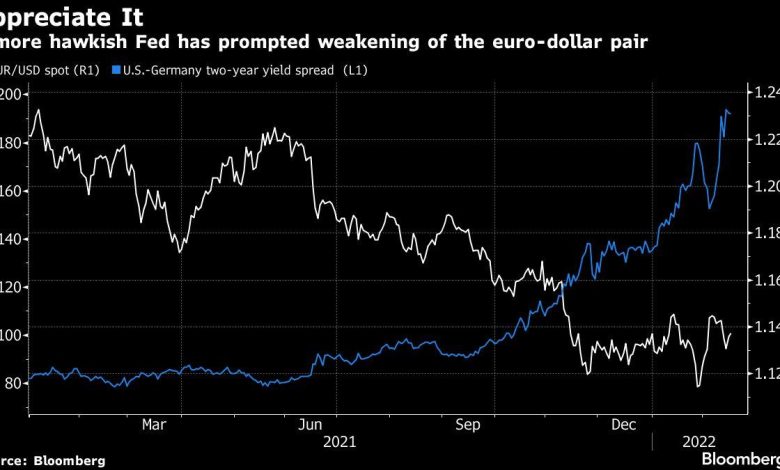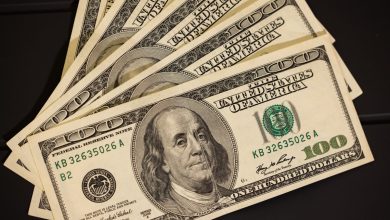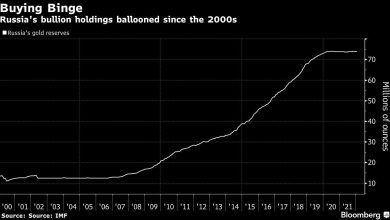Inflation Augurs New Era of Central Bank Currency Tensions

(Bloomberg) — Once accused of pushing their currencies lower to spur growth, top central bankers are now looking to appreciating exchange rates to help fight the menace of inflation.
Most Read from Bloomberg
It’s been almost 11 years since Brazilian Finance Minister Guido Mantega accused rich nations of waging a “currency war” by cutting interest rates to drive their economies out of recession through cheaper currencies, in turn pushing up the exchange rates of countries such as his.
Now, too much inflation has superseded too little growth as the primary concern for many economies. Against that backdrop, a rising currency can help cool prices by making products from abroad cheaper.
According to Bloomberg Economics’ SHOK model, a 10% gain in the dollar on a trade-weighted basis in the second quarter would knock about 0.4 percentage point off inflation in the subsequent two quarters. The impact is slightly bigger in the euro zone in the event of the euro rising 10% on a similar basis.
While Federal Reserve Chair Jerome Powell, European Central Bank President Christine Lagarde and others have avoided endorsing recent gains in their currencies, they haven’t disavowed them either.
The result is strategists at Goldman Sachs Group Inc. and elsewhere on Wall Street are declaring a “reverse currency war” is underway as policy makers find a tool for quelling inflation in strengthening exchange rates.
“The big shift is no longer thinking that currency appreciation is undesirable,” said George Cole, head of European Rates Strategy at Goldman Sachs. “It wouldn’t surprise me if we increasingly see G-10 central banks recognizing that actually a strong currency could be your friend during this tightening cycle.”
In a report to clients this week, Cole and colleague Michael Cahill suggested that as the Fed looks to tighten monetary policy more aggressively than previously predicted, counterparts will seek to keep up in part to avoid a lower exchange rate.
Goldman Sachs estimated that major central banks would need to raise rates on average by around 10 basis points to offset a one percentage point move in their trade-weighted currency. This “new paradigm” of resisting currency weakness should favor the euro, the Swedish krona and the Swiss franc.
Exchange rates may emerge as a topic as central bank governors and finance ministers from the Group of 20 hold virtual and in-person meetings in Jakarta, with a communique due on Friday. When officials last met in October, they said they’d look through price pressures that were “transitory,” a word the Fed has since retired.
Exchange rates have historically been a sensitive topic between governments who don’t want to be accused of cheapening their currencies to stoke trade or to fall foul of the U.S. Treasury’s currency manipulator report. Neither do they want a beggar-thy-neighbor race to the bottom.
Swiss National Bank President Thomas Jordan noted in December that the franc’s strength, which has impacted the economy for years, has at least helped the country escape the inflation spike seen in the euro area and the U.S.
“We have been able to prevent a stronger rise in inflation in Switzerland by allowing a certain amount of nominal appreciation,” Jordan said then. “It makes imports cheaper.”
Poland’s central bank Governor Adam Glapinski said that he would welcome a stronger zloty to “support monetary tightening,” emphasizing a shift for the central bank that had previously intervened against the currency.
The phenomenon is particularly important in smaller open economies such as Poland and Switzerland given how key the exchange rate is when it comes to inflation and the growth outlook.
“It’s a key lever of monetary policy,” said Aaron Hurd, portfolio manager at State Street Global Advisors. “So they are right to tolerate or encourage a stronger currency as part of their overall tightening cycle.”
Singapore, which uses its exchange rate as its main monetary policy tool, unexpectedly tightened in January to join the global fight against accelerating inflation, sending its currency to the strongest since October.
Bucking the Trend
For China, a stronger currency has helped offset high commodity prices that played a role in sending manufacturing costs soaring. The yuan is the second-best performing currency in Asia on a year-to-date basis, shrugging off a narrowing yield premium over U.S. Treasuries, slower growth and repeated virus outbreaks.
That’s given the central bank scope to cut interest rates as it shifts stance to support an economy suffering from a housing slump.
Japan — where too little inflation remains the problem rather than too much — is the standout from the trend. Bank of Japan Governor Haruhiko Kuroda told policy makers this week that the weak yen hasn’t boosted import costs much.
Japan’s yen has been the worst performing Group-of-10 currency since March 2020, losing 17% of its value on an inflation-adjusted basis against major trading partners, according to gauges from JPMorgan Chase & Co.
To be sure, not every economy will enjoy an inflation buffer due to a stronger currency — much depends on the make up of their inflation basket and on local dynamics, like wage gains. A stronger currency also wouldn’t do much to depress inflation in economies that rely on domestic services for growth.
But for those central banks needing to rein in prices, allowing their currencies to strengthen is a crucial tool when combined with higher borrowing costs. That will be a talking point at the G-20, said Priyanka Kishore of Oxford Economics.
“There will likely be discussion around the potential fallouts from the hawkish shift in central bank tones in many major economies, especially as a weaker currency will be an additional source of imported inflation,” she said.
(Updates yuan chart.)
Most Read from Bloomberg Businessweek
©2022 Bloomberg L.P.
Source link





